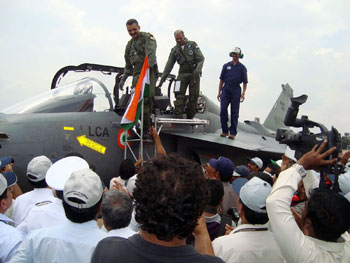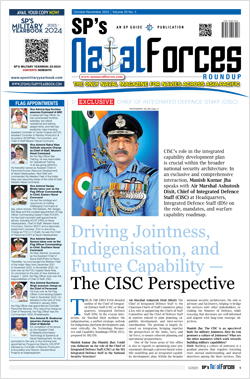INDIAN ARMED FORCES CHIEFS ON OUR RELENTLESS AND FOCUSED PUBLISHING EFFORTS

The insightful articles, inspiring narrations and analytical perspectives presented by the Editorial Team, establish an alluring connect with the reader. My compliments and best wishes to SP Guide Publications.

"Over the past 60 years, the growth of SP Guide Publications has mirrored the rising stature of Indian Navy. Its well-researched and informative magazines on Defence and Aerospace sector have served to shape an educated opinion of our military personnel, policy makers and the public alike. I wish SP's Publication team continued success, fair winds and following seas in all future endeavour!"

Since, its inception in 1964, SP Guide Publications has consistently demonstrated commitment to high-quality journalism in the aerospace and defence sectors, earning a well-deserved reputation as Asia's largest media house in this domain. I wish SP Guide Publications continued success in its pursuit of excellence.
- Global Partners Urged to Tap India's Shipbuilding Potential: Rajnath Singh at Samudra Utkarsh
- All about HAMMER Smart Precision Guided Weapon in India — “BEL-Safran Collaboration”
- India, Germany deepen defence ties as High Defence Committee charts ambitious plan
- G20 Summit: A Sign of Global Fracture
- True strategic autonomy will come only when our code is as indigenous as our hardware: Rajnath Singh
- India–Israel Joint Working Group Meeting on defence cooperation to boost technology sharing and co-development
 March 06, 2013: The LCA Navy, which has been on the ground for many months now since a short spate of just four flights starting in April last year, could take to the skies again later this year with major modifications underway to the platform's landing gear, environment control system, fuel system, lightning protection, water ingress proofing etc.
March 06, 2013: The LCA Navy, which has been on the ground for many months now since a short spate of just four flights starting in April last year, could take to the skies again later this year with major modifications underway to the platform's landing gear, environment control system, fuel system, lightning protection, water ingress proofing etc.
The LCA Navy team is currently working to complete all modifications since the Shore Based Test Facility (STBF) at INS Hansa in Goa, where the LCA Navy will conduct ski-jump trials, will be ready for take-off and recovery ops by July-August this year. Sources in Team LCA Navy say that the landing gear changes have contributed to the delays as they involve a significant amount of re-engineering. The process is being done under the technical supervisory of consultant EADS, which had been contracted some years ago to help speed up the programme in this crucial test development and test phase. A second prototype NP2 is currently under build, and will incorporate all changes being effected on NP1. NP2 will feature the fully redesigned landing gear and all other changes. The project envisages a total of five prototypes.





